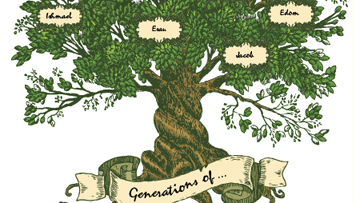You have free articles remaining this month.
Subscribe to the RP Witness for full access to new articles and the complete archives.
Genesis has three main divisions. Genesis 1–11 begins with creation and takes us up to the time of Abraham. Genesis 12–36 zooms in on the stories of Abraham, Isaac, and Jacob. Finally, slowing down to a snail’s pace, Genesis 37–50 gives us the stories of Joseph.
Genesis is also divided into eleven unequal parts by the records of the “generations.” Here is the lineup.
- “The generations of the heavens and the earth” (2:4-4:26).
- “The generations of Adam” (5:1-6:8).
- “The generations of Noah” (6:9-9:29).
- “The generations of Shem, Ham, and Japheth” (10:1-11:9).
- “The generations of Shem” (11:10-11:26).
- “The generations of Terah” (11:27-25:11).
- “The generations of Ishmael” (25:12-18).
- “The generations of Isaac” (25:19-35:29).
- “The generations of Esau (that is, Edom)” (36:1-8).
- “The generations of Esau” (36:9-43).
- “The generations of Jacob” (37:1-50:42).
These generations point to Genesis 3:15 as the book’s theme verse. “I will put enmity between you and the woman, and between your seed and her seed; He shall bruise you on the head, and you shall bruise him on the heel.” This promise is both God’s long-term plan and God’s gospel in Christ.
The word seed is a collective singular; it may refer to one or to many. If you buy a bag of grass seed, you have a bag full of seeds. On one hand, the seed of the woman is the line of believers descending from Adam and Eve, and the seed of the serpent is the line of unbelievers. On the other hand, ultimately, the seed of the woman is Christ.
Accordingly, notice how God reiterates His promise to Abraham in Genesis 22:17, “I will greatly multiply your seed as the stars of the heavens and as the sand which is on the seashore.” Compare Genesis 22:18: “In your seed all the nations of the earth shall be blessed.” Galatians 3:8, 16 offer an interpretation: “The Scripture, foreseeing that God would justify the Gentiles by faith, preached the gospel beforehand to Abraham, saying, ‘All the nations will be blessed in you’ … Now the promises were spoken to Abraham and to his seed. He does not say, ‘And to seeds,’ as referring to many, but rather to one, ‘And to your seed,’ that is, Christ.”
The structure of Genesis and of the generations emphasizes God’s gospel promise and the seed of the woman. Genesis 1-11 covers Creation, the Fall, the Flood, and Noah’s family leading up to Abraham’s father, Terah. The stories of Abraham, Isaac, and Jacob consume 25 chapters, or about 50 percent of the book. The Joseph stories make up only one “generation,” rehearsed in 14 chapters, or about 30 percent of Genesis.
The weight of Genesis is on the stories and promises given to Abraham, Isaac, and Jacob. At the same time, the generations of unbelievers receive little notice. For example, the generations of Ishmael (Gen. 25:12-18) and Esau (Gen. 36:1-8) receive short shrift. The generation of Esau (Gen. 36:9-43) is repeated to emphasize Edom’s perpetual opposition to Israel. Finally, the Joseph stories set the stage for God’s unfolding plan in Exodus.
Therefore, the structure of Genesis points us to the generations of Abraham, Isaac, and Jacob and to the promise of the gospel in Christ. As Galatians 3:29 teaches us, “If you belong to Christ, then you are Abraham’s descendants, heirs according to promise.” Genesis leads us to trust in both God’s plan and God’s gospel and to understand that we are caught up in God’s plan by God’s gospel.
Dennis J. Prutow | reformedvoice.com/rptsprof
